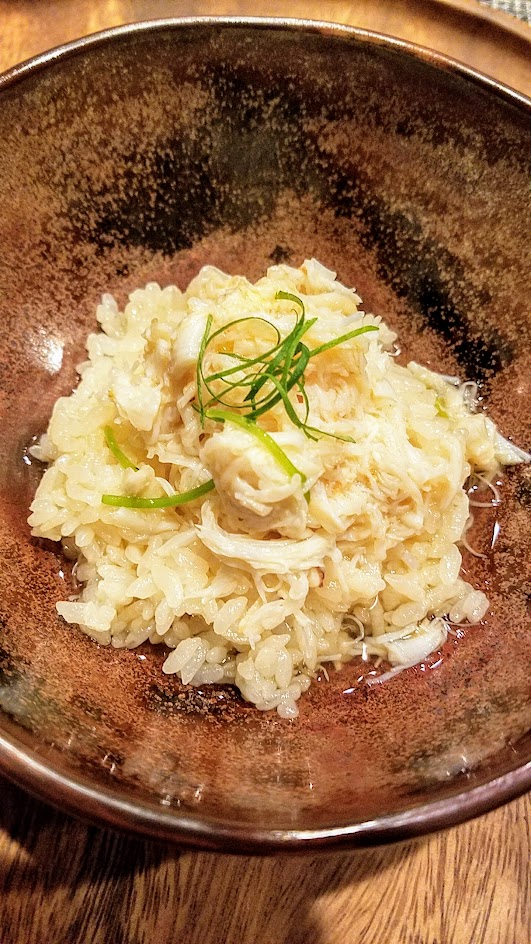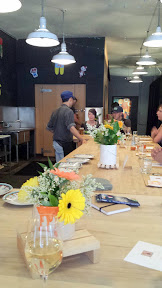I’ve written about Nodoguro multiple times, so instead of repeating myself explaining Nodoguro I’m going to just jump straight to the recap of the courses on my visit for the Nodoguro Princess Mononoke Sousaku themed dinner.


If you haven’t heard of Princess Mononoke before, this year is the 20th anniversary of the release of this Studio Ghibli Hayao Miyazaki film (Totoro, Spirited Away, so much more). The movie is a bit more scary then the others as it has more violence and frightening images as part of its story of the conflict between human progress (represented by Irontown, a town of outcasts and oppressed minorities led by a woman, representing breaking out of traditions) vs San (a girl raised by wolves and representing nature and its ancient spirits, so the princess of spirits of the title as mononoke means monster/spirit). It’s a great movie that shows the good and bad that exist for both sides in the conflict of new and old ways.
The theme was present in the Nodoguro atmosphere in an understated way with a painting of the mask of Princess Mononoke (created by Elena’s father), a little bit of white fur as a nod to Princess Mononoke’s wolf mother, and the little white figures of Kodama, the tree spirits of a healthy forest (crafted by Elena and her daughter) in a terrarium and on the counters.


I can totally imagine one day in the future a whole room that is a gallery of the various art Elena’s father creates for the theme each time and a copy of all the menus and the little centerpieces and photos of setups from the tables. Of course there should be a coffee table book to go along with the exhibit.




First: Ohitashi
Ohitashi is basically a boiled green salad. Ryan’s version here is with mustard greens splashed with ginger dashi, poached eggplant, and wonderful slices of cod smoked over cherry wood. It sounds simple but the flavors were bold and great individually or in combination together. Ryan always has a great way of cooking eggplant that makes it so meaty,, and the smoke and wood always comes through clearly in anything he smokes. The smokiness here reminded me of how in the Princess Mononoke movie in Irontown there is a lot of smoke as part of their iron forging.


Second: Squash Soup
Acorn squash soup and mushroom with young Kyoto saikyo miso, Japanese turnip greens. I really enjoyed how this soup was comforting without being heavy and is definitely tasty, unlike the soup in the movie that one character accuses a villager asking whether it is soup or water.




Third: Sashimi
Yellowtail, ume (sort of like a Japanese apricot or plum) and shiso. An interesting tidbit I learned from Elena was she described the Yellowtail here as “teenage”, and apparently depending on the age of the yellowtail, there are different names for the fish, varying from the younger hamachi to older buri. December – March is peak season for Yellowtail.

Four: Daikon with yuzu
Daikon cooked in rice water with Canadian Prawn and fermented yuzu skin and Japanese Parsley. Ryan explained that while on a recent trip to Japan with Elena he read in a bookstore how in ancient cooking the Japanese used to cook leftover Daikon in rice water. So he tried it side by side his regular method and rice water and now this is his new old way of cooking it and is the best daikon I’ve ever had.


Five: Grilled Mackerel
Grilled salt cured Mackerel, lightly toasted soy sauce, ginger blossom. I would find this satisfying just on top of plain rice for a meal.

Six: Porridge
Japanese barley made into a Porridge with 7 year aged Miso, grilled leek, and toasted walnut. It may not be the most beautiful dish of the night, but this was my favorite in terms of flavors and textures and was something I wish I could eat everyday. This is the dish most literally lifted from the Princess Mononoke film, as there is a scene where a character makes porridge for the hero

Seven: Egg and Sunchoke Salad
Egg custard, sunchoke chips, bit of a waasabi and topped with ikura and pea shoots. My other favorite in terms of flavors and textures with the creamy chawanamushi style egg and crispy sunchoke chips and the grassiness of the pea shoots and surprise bursts of the ikura fish eggs.

Eight: Nikujaga
Nikujaga, usually a traditional homemade beef and potato stew, here reinterpreted by Ryan with with egg yolk, beef tongue, and grilled onion


Nine: Salad
Shiitake, turnip, and seaweed with carrots salad, a nice acidic palate cleansing sunomono served in this cool bowl that I hope to see with uni in it one day


Ten: Rice for Gold
Rice for Gold dish is a nod to a scene in the movie where the hero Ashitaka is traveling and tries to buy rice with a gold nugget, but the villager doesn’t recognize the gold as money and causes Ashitaka to be introduced to another major character in the movie. Here, this rice really does seem luxe and worth gold, it is topped with a healthy portion of locally harvested Dungeness Crab, Wasabi, and Mitsuba. The crab you tasted was fresh, there was a a nice hint of sea and delicate softness and highlighted sweetness from the rice. Ryan has a magic way with rice.

Eleven: Miso Soup

Twelve: Tamago
Dashimaki tamago. How does Ryan even get simple egg to be so much better than tamago anywhere else in the US is mysterious… This sweet egg, here a bit milder with dashi, is always the transition to dessert and makes me a little sad to see dinner already coming to an end.


Thirteen: Dessert
Dark forest chocolate – chocolate custard with a sour cherry sauce, chocolate sugar with mint to set the scene to symbolize the return of the growth of nature to land, Served with hand roasted from leaves hojicha tea.

Every time I dine here I think how lucky I am to be able to enjoy this in my current hometown (Love you Portland!!!) and how there’s nothing else like it that I’ve experienced in the world. Even though I’ve gone to Nodoguro many times it’s always wonderful in a new way that will keep me coming back.
The tickets always sell out fast, and the best advice is to be on their mailing list for one day notice before they sell the reservations online (always on a Thursday) and follow them on social media to stay in the loop as well. Sometimes they have cancellations and you will see Nodoguro post they have an opening, so even if they are sold out for the next month, you may still have a chance to get in.


The Sousaku themes change about every 90 days – the next one is themed around Yayoi Kusama, who you may recognize from her trademark use of polka dots in her art as her way to make you as a viewer feel infinity (are they atoms? Are they stars? How incredible is it that she make simple dots deconstruct space and especially in her later works, you the viewer). She is also known as “The Polka Dot Princess” and her exhibit Infinity Mirrors is coming to Seattle Art Museum this summer (June 30–September 10, 2017).
Previously (going backwards in time) before this Nodoguro Princess Mononoke Sousaku dinner…
- Nodoguro Sousaku Dinner: Trip to Nara
- Nodoguro SupaHardcore
- Yurukyara Grand Prix, a Nodoguro Mascot Dinner
- Nodoguro Hardcore Sushi Omakase
- Nodoguro Harajuku Theme
- Nodoguro Hardcore Omakase Sushi
- Nodoguro Twin Peaks Dinner and a Guide to Nodoguro
- Nodoguro MacDonald’s Menu
- September Nodoguro Theme Totoro
- The Nodoguro Haruki Murakami August themed pop-up
- Nodoguro July 2014 Tanabata Mitsuri
- Nodoguro June 2014 Firefly Menu
- Nodoguro Pop-up: My First Time in 2014
Have you been to Nodoguro, what did you think? What did you think of this Nodoguro Princess Mononoke Sousaku theme, what theme would you like to see Nodoguro do for a future dinner?










That place looks SO cute, and oh my gosh so many delicious-looking courses!!
Elena always does such an incredible job changing the atmosphere in a cost effective way for every theme
Elena always does such an incredible job changing the atmosphere in a cost effective way for every theme
What an innovative dinner series! I learned so much just from this post (had no idea about the yellowtail). I would love to attend one of their future events!
It would make an excellent date night!